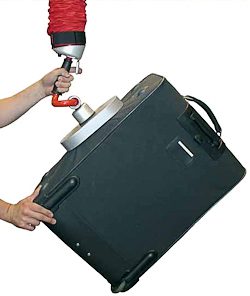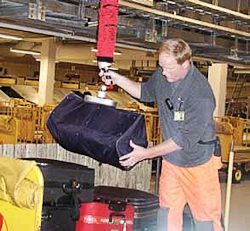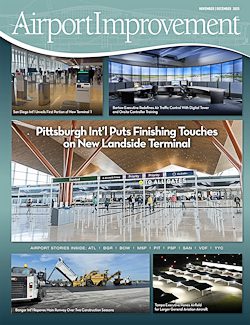 |
Historically, most TSA injuries are related to lifting heavy baggage, so agency personnel worked with IND on leveraging technology to streamline the baggage screening process. Together, they examined operations throughout the country that use a variety of lift-assist equipment such as vacuums, hoists and hydraulics. At some locations, the agency provided the equipment; at others, the airport purchased the equipment.
Ultimately, IND incorporated 12 Vaculex BaggageLift(tm) systems into the construction plan of its new terminal. Though TSA officers routinely use the equipment to lift and move checked baggage, the system is owned by the Indianapolis Airport Authority and serviced by its contracted maintenance provider.
Systemwide Improvements
“Prior to the move to the new terminal complex, officers were required to physically lift baggage from flat belts, move them to Explosive Detection Systems and transfer them to
 |
“The lift-assist system, coupled with the new 100% inline baggage screening system, has contributed to increased efficiency and decreased rates of injury.”
|
Facts & Figures Project: Lift-Assist Equipment Installation Location: Indianapolis International Airport Operator: Indianapolis Airport Authority Stakeholder: Transportation Security Administration Product: BaggageLift(tm) by Vaculex Units: 12 Equipment & Installation: $255,000 System Debut: November 2008 |
In May, John Gude, sales director of aviation and logistics solutions for Vaculex, reported even better results: 16 months of accident-free use and counting. “To my knowledge there hasn’t been a single injury since the product has been in use,” said Gude.
According to Potosnak, the concurrent debut of IND’s inline baggage handling system and lift-assist equipment also decreased personnel requirements.
IND integrated six lift-assist units into each of its two checked baggage reconciliation areas. TSA agents use the equipment as extensions of their arms – extensions with enough suction power to lift a 99-pound bag. “That covers about anything you expect to see coming down the conveyor system,” notes Potosnak.
“The BaggageLift is basically a vacuum-based product that can attach itself to baggage of different types and then allows the TSA agent to easily lift the bag with that system,” he explains. “Where this comes into play is the Level III screening where TSA agents need to take a bag from a conveyor to a workstation area to perform a check and then return it back on a conveyor.”
Vaculex systems are frequently used in package distribution centers for lifting cardboard boxes. TSA and IND personnel found the equipment adapted easily to the less uniform surfaces of airport baggage – canvas duffels, hard-sided suitcases and other shapes and textures. The system’s low-profile design also suits the drop ceilings in the airport’s checked baggage reconciliation rooms.
 |
Mid-Project Addition
After the Vaculex system was presented to the airport and TSA for consideration, it was quickly incorporated into the overall design of the checked baggage reconciliation areas. Because the project was already in progress and on a tight construction schedule, the system was implemented as a change order to an existing contract.
“The TSA went on a couple of site evaluations and then made a formal request to us to use this particular system,” Potosnak recalls. “We change-ordered that into the contract we had with Siemens, who was putting the baggage system in. Siemens just so happened to be the most convenient entity to change-order this work into their contract.”
With installation, the Vaculex systems cost $255,000. Because the lift-assist equipment wasn’t originally designed into the project, $205,000 of additional electrical and construction work was necessary to integrate the system into the building.
|
Rich Potosnak |
“In this particular instance, the ceiling height allowed for it, and allowed for easy integration into our own system,” Cox explains. “Because of extra room in the budget, the addition of that product was very easy to justify.”
With Siemens under budget on the baggage handling system, the lift-assist equipment was rolled into its contract.
“The most expeditious thing for (the airport authority) to do was to give Siemens a change order; Siemens, in turn, gave us the order for it,” Gude explains.



